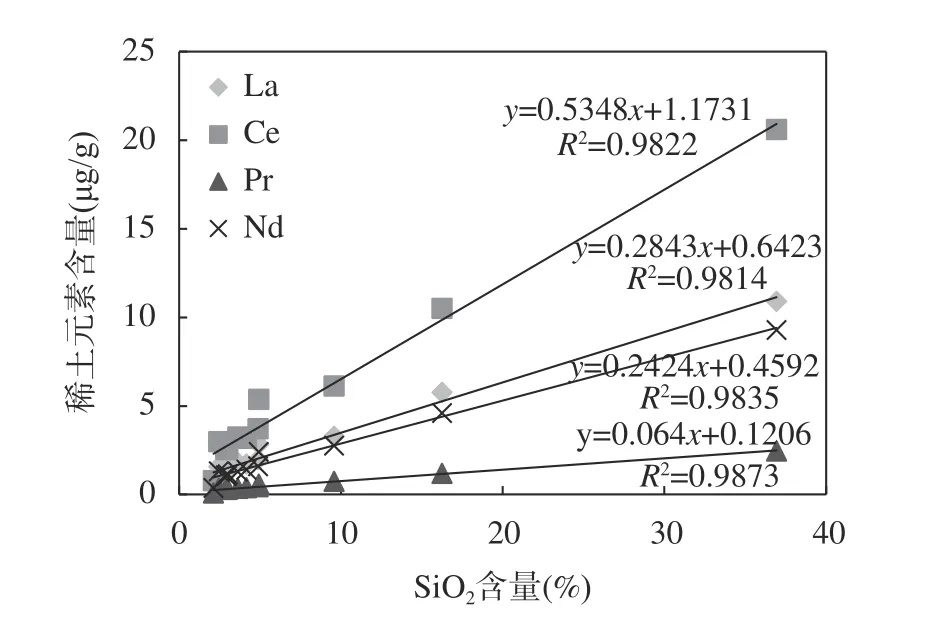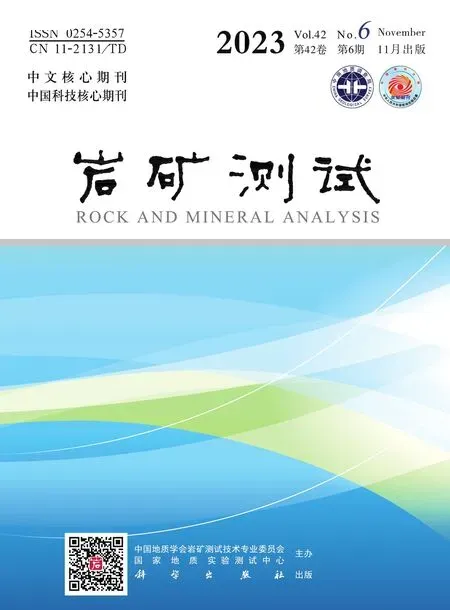西藏地区羊八井地热水中胶体粒子分析与表征
刘高令,姜贞贞,刘高博,邬国栋,苏思强,周会东,卓玛曲西,胡亚燕,李明礼*
(1. 西藏自治区地质矿产勘查开发局中心实验室,西藏 拉萨 850033; 2. 中国石油辽阳石化分公司动力运行部,辽宁 辽阳 111003)
地热水的水化学特征包含其形成过程中地质、构造、断裂、蚀变以及环境变化等多种信息,是研究地热流体形成和物质来源最基本和最重要的特征之一[1]。近年来许多学者对地热水的水化学特征开展研究,如西藏查孜、觉拥、加查象牙泉等水化学特征分析[2-4];谭梦如等[5]、刘成龙等[6]对云南勐海县勐阿街温泉、硫磺洞温泉水文地球化学特征和成因进行了分析;刘明亮等[7]研究了雄安新区地热水化学特征及其指示意义。较多学者[8-11]开展了地热水中化学元素的分析测试工作,而对地热水中的胶体粒子的分析研究工作有待加强。
目前,对天然水中胶体粒子的研究已经开展了一些工作,已有学者发现胶体粒子可以通过吸附-解吸过程影响着物质和元素的生物地球化学循环过程[12-13]。日本地热工作者Tanaka 等[14]用快速原子轰击质谱法在地热水中检测到二氧化硅的单体、二聚体、三聚体、四聚体等多聚体,但未能检测到二氧化硅球形胶体粒子;该温泉中的鲕粒蛋白石是由二氧化硅微球组成的,Tanaka 等认为二氧化硅球形胶体粒子是形成鲕粒蛋白石的关键一环。Otsu 等[15]对地热水中SiO2胶体粒子的粒径分析方法进行了模拟研究。罗雯等[16]验证了硅华中铯(Cs)的含量与蛋白石中的Q3结构有关。地热水中SiO2胶体粒子研究对热储温标公式的应用有重要的参考价值,深入研究自然条件下胶体粒子在地热水中生成和沉淀的原因十分有意义。基于此背景,开展地热水中胶体粒子的测试研究很有必要。
西藏地区地热活动强烈,地热水资源丰富,且以富含锂、铷、铯、硼等元素为特征。羊八井地热田是中国著名的高温地热田,其位于西藏自治区拉萨市西北当雄县羊八井区西侧,念青唐古拉山山前凹陷盆地的西南段,海拔4200 ~4500m,距拉萨市约90km。研究该地区地热水中胶体粒子的分析方法有助于更好地认识西藏高温地热田的水化学特点,并对西藏高温地热水的分析测试提供经验。本工作通过激光粒度仪测定了羊八井地热水中胶体粒子的粒径;透射电镜和扫描电镜表征胶体粒子的形貌;红外光谱测定胶体粒子的特征谱峰。通过实验分析得到了胶体粒子的结构成分。在此基础上,讨论了地热水中硅实验室之间分析结果相差较大原因及胶体粒子对地热水中有价元素的富集情况,为深入研究羊八井地热水中胶体粒子对铯的吸附方式和铯硅华矿床的研究提供借鉴。
1 实验部分
1.1 仪器与设备
Mastersizer 2000 型激光粒度仪(英国Malvern公司);Tecnai G2 F20 热场发射透射电镜(美国FEI公司);JSM-6700F 扫描电子显微镜(日本电子JEOL公司);X-MaxN 型X 射线能谱仪(英国OXFORD 公司);VERTEX70 傅里叶变换近红外光谱仪(德国Bruker 公司);Lambda35 紫外可见分光光度计(美国PerkinElmer 公司);Thermo iCAP6300 Duo 电感耦合等离子体发射光谱仪(美国ThermoFisher 公司);WGZ-200 型台式浊度仪(中国昕瑞公司)。
1.2 样品采集与处理
本实验选取羊八井地热旅游区蓝色天国晾晒池中地热水作为研究对象。该地热水为羊八井深层地热井ZK4001 尾水,在日光下有明显的丁达尔效应,经0.45μm 膜过滤后保存于聚乙烯瓶中。该地热水的主要特征是胶体粒子稳定、不沉淀且含量巨大。只有稳定的胶体溶液才能用各种仪器表征。胶体样品在超纯水稀释的过程中仍能保持稳定为稀释实验提供了保障。大量的胶体粒子使得过滤收集胶体粒子变得容易,并使进一步表征滤出的胶体粒子成为现实。
1.3 样品测试
为探明胶体粒子在地热水中的粒径、形貌、化学成分。通过激光粒度仪测定该地热水中胶体粒子的平均粒径;并用透射电镜(TEM)观察该地热水中胶体粒子的形貌。用电感耦合等离子体发射光谱法(ICP-OES)分别检测该地热水胶体粒子过滤前后主要化学成分。对比地热水过滤前后的主要化学成分的差别推测出胶体粒子的化学成分。
将经过0.1μm 滤膜滤出的胶体粒子经自然风干后进行能谱仪(EDS)成分分析、红外光谱(FTIR)结构特征分析、扫描电镜(SEM) 形貌表征,进一步佐证胶体粒子的成分、结构、形貌。
1.4 测试数据质量控制
电导率按《地下水质分析方法》(DZ/T 0064—2021)分析,其他检测项目按照《食品安全国家标准饮用天然矿泉水检验方法》(GB 8538—2022)分析。样品分析质量依照《地质矿产实验室测试质量管理规范》(DZ/T 0130—2006)第6 部分:水样分析质量管理要求。通过测定国家标准物质来控制准确度,精密度采用样品平行测定,判断依据数学模型:
式中:Y为重复分析相对偏差允许限(%);X为各组分分析结果浓度值(mg/L);C为重复分析相对偏差允许限系数。
2 结果与讨论
2.1 浑浊度的意义
地热水经过0.45μm 和0.22μm 滤膜过滤后,丁达尔效应依然明显(浑浊度41.7NTU),但经0.1μm滤膜过滤后变为无色,丁达尔现象微弱(浑浊度2.42NTU),可见地热水中胶体粒子无法通过0.1μm的滤膜。由此推测水体中胶体粒子的粒径大小为100nm 左右。胶体粒子被过滤后,地热水的浑浊度明显降低。浑浊度是由于水中存在悬浮物或者胶态物造成的光学散射或吸收行为引起的。通过观察地热水不同稀释比例的浊度变化趋势,证实随着稀释比例的增大,地热水的浊度随之变小,为水样报告中浊度值的解读提供了经验。分析结果见表1。

表1 样品过滤前后及稀释后分析结果Table 1 Analysis results of samples after different treatments.
2.2 胶体粒子对电导率的影响
通过比较表1 地热水过滤前后的测定结果,发现过滤后SiO2减少了1388mg/L,溶解性固体总量(TDS)减少了1786mg/L。因过滤前后地热水中其他离子变化不大,由此推断出被过滤掉的胶体粒子主要成分是SiO2。同时发现过滤后钾(K)、钠(Na)、钙(Ca)、铝(Al)的含量变少,说明这部分阳离子有可能吸附在胶体粒子表面随胶体一起被滤出。很多地热工作者通常用电导率来计算TDS[17],然而这种方法只适用基体简单的水样,对于胶体粒子含量较高的地热水其计算结果和实际结果差值较大。羊八井地热水过滤前后其电导率变化很小,但过滤前后TDS 相差很大。这是由于胶体粒子是以双电层结构存在地热水中的,这种双电层结构使整个胶团呈现电中性。在SiO2胶体粒子制备实验中,胶体粒子成长后电导率值趋于最小并保持稳定[18],因而胶体粒子的存在对样品的电导率贡献较小,但是对TDS贡献较大。
2.3 SiO2 和H2SiO3 分析结果的不同意义
由于目前没有地热水检测的国家标准,地热水中硅的检测方法是依据《食品安全国家标准 饮用天然矿泉水检验方法》(GB 8538—2022),而标准中硅的检测方法有两种方法:一种是ICP-OES 分析的SiO2;另一种是硅钼黄(蓝)光谱法即紫外可见分光光度计(UV-Vis)测得的H2SiO3。一般来说,UV-Vis 测得的H2SiO3为大家熟知的偏硅酸即可溶性硅酸[19-20],而ICP-OES 测得的SiO2为地热水中的全硅。一般矿泉水中的硅含量较低,其主要以偏硅酸的形式存在,这种情况下两种方法测得的硅含量接近。但一些地热水中的硅含量高,存在形式复杂,这类地热水中同时存在着偏硅酸和硅酸的多聚体[14]和胶体粒子,这时两种方法测得的硅含量差别较大。而个别科研人员将ICP-OES 测得的SiO2和UV-Vis 法测得的H2SiO3二者结果相互转换使用。这是地热水中硅的实验室间比对结果差别较大[21]的一个原因。通过对比表1 中ICP-OES 测得的SiO2和UV-Vis 测得H2SiO3的分析结果相差较大。而经过0.1μm 滤膜滤出胶体粒子后,两种方法的硅分析结果差值由1387.5mg/L 缩小到41.65mg/L,这种巨大的变化说明该胶体粒子可以被ICP-OES 检测,但不被UV-Vis检测。其原因是胶体粒子可以被等离子体产生的高温激发,但不能与钼酸铵显色,因此可以通过ICPOES 和UV-Vis 的差值来判断样品中胶体粒子的含量。地热水稀释后UV-Vis 测定值会明显增加,但即使稀释到100 倍ICP-OES 测定值仍然大于UV-Vis测定值,说明通过稀释可以使部分的SiO2胶体粒子转化为H2SiO3。
2.4 样品表征结果
对地热水中的胶体粒子进行了一系列的表征。首先通过激光粒度仪测定了地热水胶体粒子的平均粒径为80.83nm。随后进行透射电镜(TEM) 表征,将地热水滴到待测铜网上,待自然挥发后上机测定。从图1 中a、b 中可以看到羊八井地热水中含有大量的胶体粒子,因样品未经超声等任何处理,该电镜图片中胶体粒子的形态接近于胶体粒子在地热水中的形态,胶体粒子的粒径集中分布在50~100nm 之间。同时将地热水中的滤出物进行了扫描电镜(SEM)分析,从图1 中c、d 中可以看出滤出物呈球形,且粒径分布在100nm 附近,这也与之前激光粒度仪分析的结果相吻合。

图1 胶体粒子的透射电镜和扫描电镜图像Fig. 1 The TEM patterns and SEM patterns of colloidal particles.
为了进一步确定滤出物的成分,进行了能谱仪(EDS)分析(图2),结果表明滤出物主要为硅氧化合物,且硅氧质量比为0.83,接近SiO2的理论值0.88,从而也印证了胶体粒子的主要成分为SiO2。同时能够发现,除了含有Si、O 元素外,还含有少量Na、K、Cl、Ca 元素,说明胶体粒子在滤出时会携带其他离子。

图2 胶体粒子的能谱分析(EDS)图谱Fig. 2 The EDS spectrum of colloidal particles.
为了进一步确定胶体粒子的结构,将滤出物自然风干后进行红外光谱(FTIR)表征。从图3 可以看出在1073cm-1、796cm-1、593cm-1三处有十分强烈的吸收,1073cm-1处为Si—O—Si 反对称伸缩振动,796cm-1和593cm-1处为Si—O 键对称伸缩振动,该滤出物的特征吸附峰和蛋白石的红外吸收峰位相吻合[22-24]。证实了该胶体粒子与蛋白石有密切的关系[14]。

图3 胶体粒子的红外光谱图Fig. 3 The FTIR spectrum of colloidal particles.
对于一些文献中认为不可溶性硅是硅聚合物、SiO2胶体粒子[25]的猜想,通过对地热水中SiO2胶体粒子的TEM、SEM、FTIR 表征证实了该猜想。
2.5 胶体粒子行为的影响
地热水中SiO2含量与热储温度有特殊关系,地热工作者建立了不同SiO2地热温标公式,如无蒸汽散失的石英温标、玉髓温标、无定形SiO2温标计算地热水温度[26],不同的温标公式对应着不同应用条件。但地热水中SiO2有不同的聚合度,聚合度大的形成胶体粒子,而胶体粒子容易沉淀从而导致该类地热水的热储温度偏低。上述研究可以计算地热水中胶体粒子的含量,因而本研究对地热温标应用有重要参考价值。
由于SiO2胶体粒子有吸附地热水中金属离子的能力,这为铯硅华的形成机理提供依据[25],即SiO2胶体粒子表面大量的活性羟基基团可以吸附铯而形成含铯硅华[27]。通过ICP-OES 测定胶体粒子滤出物中的铯,结果表明胶体中铯含量为0.15%。SiO2胶体粒子对铯的优异富集能力是西藏铯硅华形成的原因之一。由于SiO2胶体粒子对高价阳离子具有更强的吸附能力[28]且西藏地区部分泉华中发现了稀土元素的存在,因而可以进一步研究稀土元素与SiO2含量之间的关系。多格错仁南岸地区共有100 个以上的盐泉钙华沉积点,盐泉平均盐度能达到41.22g/L[29]。本次研究发现西藏多格错仁南岸钙华中的轻稀土元素与SiO2含量呈显著正相关(图4),这一发现意味着盐泉水中的SiO2和轻稀土元素的富集有密切关系,SiO2在高盐度下富集轻稀土元素的行为,为廉价易得的SiO2胶体[30]富集地热水、盐湖水中有价元素提供了可能,同时也为盐湖资源、地热水资源开发提供一个新的解决方案。

图4 稀土元素与SiO2 关系图Fig. 4 The relationship between rare earth elements and SiO2.
3 结论
地热水中天然存在的SiO2胶体粒子常因为含量少、易沉淀、难收集等原因,导致对胶体粒子的研究进度偏慢。而本实验选取的羊八井地热水胶体含量大、稳定、不沉淀,能把天然胶体粒子的各种特性展现在地热工作者面前。研究显示胶体粒子的存在增加了地热水的浑浊度,但并未增加地热水的电导率。采用TEM、SEM、激光粒度仪、ICP-OES 等分析方法研究了羊八井地热水中胶体粒子的组成。结果表明:地热水中高含量的SiO2以偏硅酸和胶体粒子的形式共同存在于水中,该胶体粒子可以被ICPOES 法分析,但不会与钼酸铵显色。地热水中SiO2胶体含量可以通过计算SiO2和H2SiO3的差值而得,SiO2胶体粒子相对稳定不宜沉淀,通过稀释可以使部分的SiO2胶体粒子转化为H2SiO3。SiO2胶体粒子在滤出的过程中会吸附地热水中的金属离子。
本工作揭示了地热水中硅的两种常见存在形式(偏硅酸和胶体粒子),为地热水中硅实验室间比对结果差别较大作了合理解释。但除了这两种常见的存在形式,地热水中SiO2的其他存在形式还有待开展研究。影响SiO2胶体粒子在地热水中稳定存在的条件还未厘清,如何消除SiO2胶体粒子对地热水中Ca、Al、Cs 等分析元素的干扰值得研究,进一步研究SiO2富集铯和轻稀土元素的机理十分有意义。
Analysis and Characterization of Colloidal Particles in Yangbajing Geothermal Water, Tibet
LIU Gaoling1,JIANG Zhenzhen1,LIU Gaobo2,WU Guodong1,SU Siqiang1,ZHOU Huidong1,ZHUO Maquxi1,HU Yayan1,LI Mingli1*
(1. Central Laboratory of Geological Mineral Exploration and Development Bureau of Tibet Autonomous Region,Lhasa 850033, China; 2. Power Operation Department of Petro China Liaoyang Petrochemical Company, Liaoyang 111003, China)
HIGHLIGHTS
(1) There are colloidal silica particles in the geothermal water of Yangbajing, with an average particle size of 80.83nm, which makes it easy to adsorb metal ions in the geothermal water.
(2) The strong adsorption capacity of SiO2colloidal particles for cesium is one of the reasons for the formation of geyserite in Tibet.
(3) The content of SiO2colloidal particles is the difference between SiO2measured by ICP-OES and H2SiO3measured by UV-Vis.
(4) SiO2measured by ICP-OES and H2SiO3measured by UV-Vis have different meanings and cannot be converted into each other.

ABSTRACT BACKGROUND:The hydrochemical characteristics of geothermal water include various information such as geological, structural, fracture, alteration, and environmental changes during its formation. It is particularly important to analyse various components in geothermal water accurately.Tibet is rich in geothermal resources, and some geothermal water contains colloidal particles. It is of great significance to study the morphology, composition and structure of colloidal particles for understanding the relationship between the material sources of geothermal fluids and colloidal particles. The generation and precipitation of colloidal particles can affect the turbidity, conductivity, and partial cation content of geothermal water. It is not easy to obtain naturally formed colloidal particles in geothermal water, so there are few reports on the analysis of colloidal particles in geothermal water.OBJECTIVES:To analyze colloidal particles in geothermal water accurately by multiple methods, and understand the relationship between colloidal particles and opals, and the impact of colloidal particles on the analysis of other elements in geothermal water.METHODS:By comparing the changes in the main components of the water samples before and after filtration, the composition of colloidal particles was inferred. The composition and structure of colloidal particles in the filtrate were characterized by scanning electron microscopy (SEM) and other instruments. The particle size of colloidal particles in geothermal water was measured by laser particle size analyzer, the morphology of colloidal particles was characterized by transmission electron microscope (TEM) and SEM, the characteristic spectrum peak of colloidal particles was measured by Fourier transform infrared spectroscopy (FTIR), the main composition of colloidal particles was analyzed by energy dispersive spectrometer (EDS), and the content of silicon in geothermal water was determined by inductively coupled plasma-optical emission spectrometry (ICP-OES) and ultraviolet-visible spectrophotometry (UV-Vis).RESULTS:The colloidal particles in geothermal water are colloidal silica particles. High levels of silica in geothermal water are present in the form of soluble silicic acid and colloidal particles. The average particle size of the colloidal particles is 80.83nm, which is related to the formation of cesium silica and the enrichment of light rare earth elements. The colloidal particle can be analyzed by ICP-OES method, but cannot show color with ammonium molybdate, resulting in a significant difference in the results of using UV-Vis and ICP-OES to determine silicon in this type of water. ICP-OES is a more suitable detection method for geothermal water with high silicon dioxide content. Silicon dioxide can be directly measured whether it exists in the form of metasilicic acid or colloidal particles.CONCLUSIONS:The research shows that the presence of colloidal particles increases the turbidity, but not the conductivity, of geothermal water. The results show that the high content of SiO2in geothermal water co-exists in the form of metasilicate and colloidal particles, which can be analyzed by ICP-OES but cannot show color with ammonium molybdate. The content of SiO2colloidal particles in geothermal water can be obtained by calculating the difference between SiO2measured by ICP-OES and H2SiO3measured by UV-Vis. SiO2colloidal particles are relatively stable and not easy to precipitate. SiO2colloidal particles will adsorb metal ions in geothermal water during the filtration process.
KEY WORDS:geothermal water;SiO2;metasilicic acid;colloidal particles;energy spectrum-scanning electron microscopy;inductively coupled plasma-optical emission spectrometry

